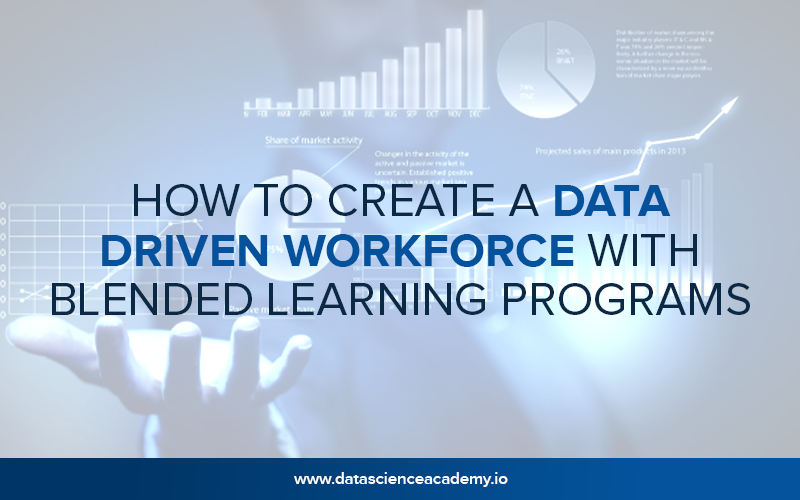
How to Create a Data-Driven Workforce with Blended Learning Programs
As organizations create additional knowledge and digital products and processes, the employee based on the data was not particularly important at all. Therefore, learning and training have become the focus of the business approach, especially initiatives aimed at developing data science skills in organizations. The growth of communication technology has enabled a dispersed team culture. These teams include employees who work on client’s websites, employees who work from home, and employees who work remotely. A decentralized employee in remote locations is essential to the team.
The challenges and problems of decentralized workforce management have increased over time. Organizations are under pressure to assess and respond to the training needs and aspirations of a diverse workforce to help them achieve and exceed their goals. This presents unprecedented challenges to the blended learning and development initiative. Through blended learning, organizations can increase economies of scale to reduce costs while improving performance and is based on three main training methods:
- Lessons were led by direct and personal instructors
- Digital e-learning, which can include video, audio, and other multimedia content
- The planned time for independent learning based on lessons and electronic learning materials
Business Goals of the Company
No method of learning is effective if employees do not use the acquired knowledge in practice. As with any learning process, you must first set clear goals or challenges that you want to overcome with your training. Once you have defined the goals and implementation of blended learning, you need to constantly monitor the results of your employees and measure their progress so that you can change the content of the training as needed.
Though - it can be difficult to gather accurate data for analysis alone. This way, you can provide strong support and feedback to your employees to understand if your training plan is effective.
Data-Driven Tips for Effective Employee Training
Here are some tips you can use to make the most of training in your company and better develop your employees to develop skills that benefit them and the company.
Let Employee Training Be a Job Opportunity
Studies show that a limited career is another common reason for workers to retire. Instead of simply offering employee training, such as data analysis training, as an opportunity to create and maintain a corporate culture or to be consistent, find ways to turn it into a career and an opportunity for continuous professional development for your employees as well.
However, 85 percent of employees do not actively participate or do not participate in the work. Today’s workers have 60-70 years of career ahead of them; they expect employers to help them find themselves again. Thus, 94% of employees would stay in the company longer if they invested in shaping their careers.
Focus On Abilities of the Future
If you want to involve your employees in training, focus on developing skills - that will help them stay in our fast-paced and digital world. A recent survey found that although conversations about automation, artificial intelligence, and retraining skills dominate conversations about the future of the job, 45.3% of employed Americans say they care about switching the environment of their profession.
In a matter of fact, according to the study, up to 375 million workers will have to change jobs by 2030 due to automation. Make learning more effective by focusing on the future of your business, because when it comes to a particular role of your company, a particular team, or your employees, 74.4% of people are willing to work or retrain to stay in the future.
Make Employee Training Cooperative
Learning doesn’t have to be the only asset of your employees. Though 80 percent of all learning in a company takes place through communication in the workplace. If you offer your employees self-learning opportunities, it might be a good idea to try collaborative development opportunities as well, using features like online chat rooms, social media videos, and video tools to enhance your organization’s virtual training. Assess their ability to gain different types of collaboration opportunities through surveys that allow you to determine what best suits your team.
Encourage Better Manager Support
Manager support is a big factor in whether employees see themselves learning and growing in the process. However, 63% of the US workers strongly agree that support is conducive to career development. Without this support, only 48% of employees are interested in giving their best, while 85.8% of employees receive this support.
Instead of looking at training as an opportunity to learn, consider the day-to-day experiences of team leaders as a way to change learning continuity. Regular feedback is needed for workers, who want to train and want feedback 50% more often than other workers.
Creating a Modern Learning Culture
Do not offer training as an added benefit of working as a company employee. Instead, add it to your culture and turn it into the key to your company’s DNA. To make this possible, focus on training staff as needed, rather than simply performing one or two core exercises a year.
Blended Learning: Its Essence and Tips on How It Works
Blended learning refers to promoting participation and improving data aspects by providing data analysis training, using modern technology with the direct support of trainers. This means that the use of technology and e-learning to enhance and facilitate the learning and development of professionals and experts in the learning process, resulting in better performance and productivity. This flexibility allows people to acquire knowledge independently by performing a variety of training tasks, watching videos, listening to podcasts, and more. As well as participating in direct group discussions, observing more experienced colleagues, pieces of training and observations.
However, 68.4% of users use a combined approach to employee training and combine mentoring and independent training instead of one method, which is reasonable. By combining traditional learning and technology, you get testimonials, communication, quick and easy access to different types of content, reviews, and, if necessary, support, progress monitors, and communication training.
Wrap-up
Modern companies operate in an age of high technology, completely changing skills, and intense competition. Although design skills are available to facilitate transportation, it has not been studied in a mixed environment. It is therefore not surprising that international spending on training and staff development has been steadily increasing over the last ten years.
